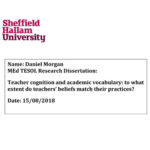Foreword May 2012
Tariq Elyas and Michelle Picard
King Abdulaziz University, Saudi Arabia The University of Adelaide, Adelaide, Australia
TESOL Diversity and Depth
The presentations at the Asian EFL Journal International Conference 2011 once again illustrated the huge diversity of topics affecting the teaching of English. The variety of the conference and the field as a whole is reflected in this special conference edition of the Asian EFL Journal. The four papers span teacher competency, program evaluation, the effect of teacher questioning on student behaviour and insights from the field of translation providing useful inputs to all TESOL academics and teachers. They also make use of a variety of methods including quantitative statistical analysis, thematic qualitative analysis and translation techniques. In the first paper, Competencies of teachers in English in Northern Isabela and Selected Variables by John N. Cabansag the relationship of teaching competencies with other variables (educational qualifications, demographic variables and problems of secondary school teachers) is explored in the context of Northern Isabela in the Philippines. The author utilizes the descriptive correlation method of research in his study. The results demonstrate that despite expectations to the contrary, demographic variables such as age and gender, civil status and number of children have no relation to English teacher competencies. Likewise, qualifications and years of service do not affect competency in the classroom and although teachers may experience difficulties due to a lack of resources and institutional/government support, this does not affect the quality of their teaching. Instead, the author suggests that individual factors related to the personality and resilience of the teacher affect their competency and suggest that in-service training and collegial support should be provided for English teachers to optimize their effectiveness as teachers; and team teaching shall be encouraged and instituted involving all English educators to share experiences in the teaching of the subject.
The case of The New English Program for Elementary School Students in Japan by Junko Horie investigates the new implemented educational policy in Japan to include English courses for students from Grade 5. He utilized semi-structured interviews with various stakeholders and questionnaires to find out the limitations of such policy within the Japanese context. The author concludes that central coordination, more effective training and provision of resources along with better lesson planning are key elements for the success of the new English policy in Japan.
Elmer Delima s paper, A Reticent Student in the Classroom: A Consequence of the Art of Questioning , addresses the importance of teacher s behaviours, particularly when formulating questions and their effect on students behaviour. Delima debunks assumptions on the reticence of Asian students and instead highlights family factors such as the presence of the mother and the treatment of the child within the family as reasons for reticence and provides advice to teachers to encourage participation from reticent students. The final paper, Speech Acts in Drama Translation , Marjan Ghourchian analyses a sample of five English plays and five Persian plays and their translations and evaluates the language forms used in the various documents. Although the plays in both languages use direct forms predominantly, indirect forms cause the most problems in translation. Ghourchian describes the predominant forms in each of the plays and provides translators (and English teachers) with advice on how to handle these various language features.
The detailed data and in-depth analysis in these papers have the potential to inform language policy, curriculum design and pedagogy. We hope that Asian EFL Journal Readers will enjoy this issue.
Tariq Elyas, King Abdulaziz University, Saudi Arabia Michelle Picard, University of Adelaide, Australia








